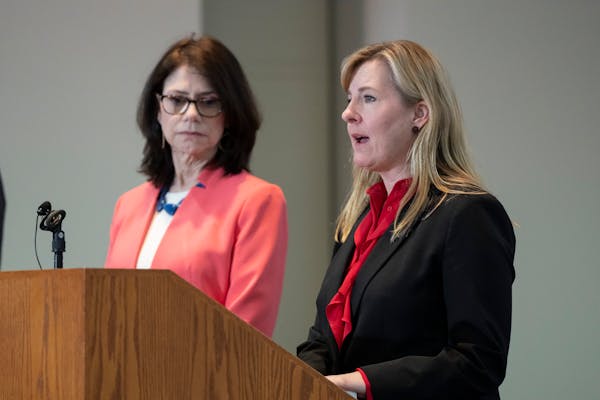The knock on Democrats at the state Capitol these days is they spent a $17 billion surplus, the largest in absolute dollars Minnesota has ever seen, and raised some taxes to boot.
That's technically true, and it will probably remain a media narrative and attack line for state Republicans, who thought far too much money was spent and wanted more returned to taxpayers.
The focus on the surplus misses something more important, however.
Democrats increased the size of state government not just by using the surplus, but by keeping its source: a surprise surge in revenue after the pandemic like some businesses experienced.
One of those was Target Corp. After being deemed an essential retailer at the onset of the pandemic, Target's revenue in 2020 and 2021 soared far above executives' wildest expectations.
By the start of 2022, they reset Target's operations expecting that future revenue would remain at the new higher level, which it has, except for a small dip this summer.
Gov. Tim Walz, Senate Majority Leader Kari Dziedzic and House Speaker Melissa Hortman this spring did the same thing with the State of Minnesota.
They dubbed it "Minnesota Miracle 2.0," a callback to legislative sessions of the early 1970s that created our modern-day state government.
In a conversation at the Capitol last week, Dziedzic and Hortman described how they made those decisions and why they're confident they will help grow Minnesota's middle class and economy. It may take years to know, though.
"You can't necessarily monetize the return on investment for a lot of what we do at the Legislature," Hortman said. "It's not like Target opening another store."
I criticized the state leaders this spring for deciding to spend all of the surplus, and I later wrote about how the state's fiscal growth was far surpassing its economic growth.
It's way too early to call the outcome of the legislative session a miracle, though Dziedzic and Hortman managed it impressively. I'll be pleased if their work spurs anything close to the growth Minnesota had in the 1970s.
For now, I remain guarded about the divergence between the growth of state government and leveling off of Minnesota's population and workforce size. That interplay is our version of an economic mystery, akin to how the U.S. this year has withstood recession while enduring the highest interest rates in 22 years.
This spring was the first time in a decade that Democrats controlled both bodies of the Legislature and the governor's office.
The two legislative leaders worked together with just a one-vote majority in the Senate to pass a long list of progressive goals — paid family medical leave, free school lunches, legal marijuana, free state college tuition for some, carbon-free electricity by 2040 — as Walz refereed their rare disagreements.
"Most of the policies that we passed are things we've known we've needed to do for 20 years or more. So we invested in things that are kind of solid, like higher education, early childhood education, housing and transportation," Hortman said.
"Basics. A lot of just basics that people need," Dziedzic added.
The difference was the amount of money they had to put toward their priorities.
State revenue climbed higher than anyone expected during the two years ended June 30, helped by big growth in tax collection on Minnesotans' non-wage income. It hit $60.7 billion, far more than the $51 billion expected when the two years began. By last fall, it was clear to state officials the new level of revenue could be sustained into the future.
And so, just as at Target, Walz and Democratic legislators reset the state's operations, outvoting Republicans who objected. Spending from the state's general fund, which grew an average of 4% annually over the last decade, is set to grow by an average of 6% annually for the next four years.
The budget for the next two years spends the unexpected revenue from the last two; in other words, the widely-talked-about $17 billion surplus.
About $3 billion of the $17 billion was returned to taxpayers in the form of a one-time rebate for people with incomes below $75,000, a break on Social Security income, a child tax credit, a change in the renter's credit and some smaller cuts.
They added $1 billion in new taxes, with about half of that coming from a tax on businesses conforming with a Trump-era federal tax on foreign income.
The change in tax mix was designed to hit a revenue figure of $60.8 billion during the two years that began in July and end in June 2025. A few years ago, state officials expected revenue in that period to be around $54 billion. That's the reset upward.
"Where the budget targets land is a balance between funding the needs that are most important with the revenue we have now and believe we'll have in the future," Hortman said.
A Republican-led Legislature might have set a lower revenue target, somewhere between $54 billion and $61 billion, and cut some taxes as a result.
"When we looked at Minnesota's budget, we said we're not spending enough to get the things that people value accomplished, such as sufficiently funding our education system, not just to persist but to be better in the future," Hortman said.
When the books recently closed on the 2023 fiscal year, the state appeared to again be taking in more revenue than it's spending, perhaps a $2 billion surplus. A precise estimate comes in a few weeks.
That means legislators may want to spend even more when they reconvene in February, but the two leaders are already trying to tamp that down.
"People should not be thinking that 2024 has become a major budget year," Hortman said.
Child care, which the Legislature addressed this spring in bills aimed at providers and consumers, is one issue that may get further review.
"There was money in seven bills to deal with child care, but we still are hearing 'We can't afford child care. We can't afford child care,'" Dziedzic said.
Next year's election may also create caution about spending. House members are on the November ballot, and Republicans can take control by winning four seats.
GOP lawmakers routinely criticized this spring's spending decisions. And before next year's election, more spending choices have to be made.
Legislators will decide what capital spending requests – state agencies have sent in $7 billion worth so far – should be funded by issuing bonds.
The leaders said they'll be measuring outcomes from their 2023 decisions as soon as this spring, though they expect most results will take longer. Affordable housing could take three to six years to be built, and schools will need at least five to see gains in student performance, Hortman said.
Dziedzic said she wants a pretty immediate review of the child tax credit and one on nursing homes to be sure state funds are boosting workers' pay.
"One of the most important things is making sure the money we're investing is actually reaching the people that we want it to reach," she said.

Ramstad: Biden, Trump show how hard it is to let go of power, identity
Ramstad: In a chaotic moment, Americans still have power over what's next
Ramstad: In a big change to nation's corn, you might soon see shorter stalks

Ramstad: Human progress is not the enemy of the planet






